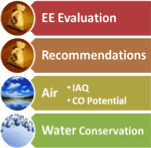The Process

Many building factors affect the energy efficiency of each home. This requires a comprehensive evaluation for each home. Age of home, orientation, building materials and workmanship all affect energy efficiency of your home. There is no one size fits all.
Free Energy Assessment
An energy assessment is a good place to start. This is a great orientation to develop a basic understanding of EE for your specific home. The energy assessment is an hour consultation that includes a basic inspection, utility bill review, and rebate qualification. A report will be produced to help client understand the current EE and recommendation of EE improvements. The homeowner will have a good understanding of rebates that they may qualify for.
Energy Assessments
The energy assessment is the core of the EE process. Homeowners are often surprised how informative the energy assessments can be. Not only utility savings and comfort benefits, but health and safety become important benefits. At times, they can become equally important. Homeowners also appreciate the education along with practical behavioral changes recommendations to improve the EE to their home.
The assessment is a comprehensive process. The assessment consists of an interview, inspection, building measurements, documenting building materials, appliances, lighting, diagnostics and analysis. This process can take anywhere from 4 to 6 hours onsite.
The assessment produces a comprehensive energy assessment report. It consists of an assessment of energy usage and savings, recommended improvements and efficiency gains. The report can also include a Calif. Energy Commission Whole House Rating certification.
Utility Bills
The assessment requires review of utility bills. Two years of bills are recommended to average monthly and seasonal demand. This improves the accuracy of the results. Homeowners can request to get this information digitally from SDGE directly.
Inspection
An energy inspection of the property evaluates for specific conditions that effect the EE performance, conservation and related health & safety conditions.
- Insulation in attic, walls, crawlspace
- Venting conditions in attic and crawlspace
- Gas line installations and leakage
- Appliances EE performance
Measurements – Take Offs
The house size is measured for square footage, cubic feet, orientation, window & door size & type, type of exterior materials. This information is key in determining homes EE performance.
Diagnostics
Several diagnostics tests are performed to determine specific conditions. Pressurization conditions determine efficiency of your home and ducting system.
Another important test is known as the CAS/CAZ test.
|
Blower Door |
Pressurize the living area of the home to measure air leakage to the outside |
|
Duct Blaster |
Pressurize heating/cooling ducting system to measure leakage. Older ducting systems leak an average of $30% or more. |
|
CAZ |
Create worst-case scenario to determine if any gas combustion appliances can backdraft combustion gases creating a health hazard |
|
CO |
Carbon Monoxide test of all gas appliances including stove, fireplace, water heater and furnace |
Analysis
The analysis brings it all together. The measurements and diagnostics are compiled into an energy modeling program. The modeling program is a standard tool used by energy consultant, HVAC contractors to model energy efficiency compliance, sizing heating/cooling capacities for residential and commercial buildings.
After analysis, the assessor inputs potential EE improvements. It will also rank the EE improvements in terms of which improvements provide the highest EE gains.
Reports
The assessment includes a series of reports to convey the results. It includes an analysis of current utility usage by electrical and gas and then by season. This informative report also includes energy usage breakdown by appliances, lighting heating, A/C and more.
The key report is the energy upgrade recommendations that are ranked by EE improvements. The homeowner can now identify the most cost-effective improvements towards the best energy efficiency.















Follow Us!